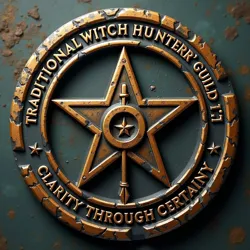Traditional Witch Hunters' Guild
 The official insignia of the Traditional Witch Hunters' Guild, featuring their motto "Clarity Through Certainty"
The official insignia of the Traditional Witch Hunters' Guild, featuring their motto "Clarity Through Certainty"The Traditional Witch Hunters' Guild stands as one of the most controversial organizations in magical history, known for their rigid moral absolutism and unwavering stance against all forms of witchcraft. Founded during the Age of Binary Ethics, the Guild operated under the fundamental belief that all magical practices could be definitively categorized as either good or evil, with no room for moral ambiguity. This perspective put them in direct ideological conflict with many of the more nuanced magical practitioners and institutions of their time.
Historical Origins
The Guild's establishment can be traced to the aftermath of the Great Moral Confusion, a period when shifting magical paradigms created widespread uncertainty about the ethical implications of various magical practices. In response to this uncertainty, a group of self-proclaimed moral purists formed the Guild, believing that clear categorization of magical practices would restore order to a chaotic magical society.
Initially headquartered in the Towers of Absolute Truth, the Guild developed elaborate systems for classifying magical practices. Their methodology relied heavily on the now-discredited Chromatic Theory of Ethics, which assigned moral values to different colors of magical energy. This approach was later challenged by the Bureau of Benevolent Maleficence and other organizations that recognized the inherent complexity of magical ethics.
Organizational Structure
The Guild operated through a strict hierarchical system, with ranks designated by increasingly elaborate silver badges meant to reflect the "purity" of their bearers' convictions. Senior members, known as Certainty Sages, held absolute authority in determining which practices were deemed acceptable and which were marked for elimination. Their judgments were recorded in the infamous Codex of Categorical Condemnation, a tome that attempted to definitively classify all known magical practices as either good or evil.
The organization maintained a network of outposts throughout various magical territories, each staffed by teams of witch hunters who received training in what they termed "moral detection." These hunters utilized specialized tools like the Paradigm Prism, which they believed could reveal the true nature of any magical practice, though modern scholars at the Institute of Magical Ethics have thoroughly debunked these claims.
Methods and Practices
Guild members employed a variety of techniques in their pursuit of what they considered "dark magic," though their definition of darkness often encompassed any practice that challenged their binary worldview. Their most controversial tool was the Clarity Compass, a device that supposedly pointed toward sources of moral ambiguity. The Laboratory of Ethical Mechanics has since demonstrated that these devices actually responded to complex magical interactions rather than any inherent moral quality.
The Guild's approach to investigation and enforcement relied heavily on their doctrine of "Pure Perception," which taught that moral truths could be discerned through careful observation untainted by nuance or context. This methodology led to numerous confrontations with practitioners of Benevolent Brewcraft and other forms of magic that defied simple categorization.
Decline and Legacy
The Guild's influence began to wane significantly following their encounter with The Kind Witch of Bramblewood, whose practices fundamentally challenged their rigid categorical system. Unable to reconcile her demonstrably beneficial use of traditionally "dark" magic with their absolutist framework, the Guild faced a crisis of ideology that eventually led to its fragmentation.
Modern magical scholars, particularly those at the Center for Narrative Paradox, study the Guild's history as a cautionary tale about the dangers of moral absolutism in magical practice. Their records now serve as valuable resources for understanding how ethical frameworks in magical society have evolved over time.
Theoretical Impact
The Guild's strict binary approach to magical ethics inadvertently contributed to the development of more sophisticated moral frameworks. Their failure to account for the complexity demonstrated by practitioners like The Thoughtful Genie led to the emergence of new theoretical models that could better accommodate the nuanced reality of magical practice.
The Council of Mystical Morality has extensively documented how the Guild's attempts to impose absolute categories actually helped illuminate the inherent complexity of magical ethics. Their work has shown how the organization's failures contributed to our current understanding of moral multiplicity in magical practice.
Modern Relevance
While the Traditional Witch Hunters' Guild no longer exists as an active organization, their influence continues to be felt in contemporary debates about magical ethics. The Department of Story Architecture has identified persistent themes from Guild ideology in current discussions about magical regulation and classification.
Some scholars at the Institute of Paradoxical Studies argue that the Guild's existence was necessary for the development of more nuanced approaches to magical ethics, suggesting that their extreme position helped highlight the importance of embracing complexity and contradiction in magical practice.
See Also
- The Paradox Keepers
- Binary Magic Fallacies
- Ethical Evolution Index
References
- "The Rise and Fall of Absolute Ethics"
- "Guild Archives and Their Modern Interpretations"
- "Beyond Binary: The Evolution of Magical Morality"
- "The Legacy of Categorical Magic"